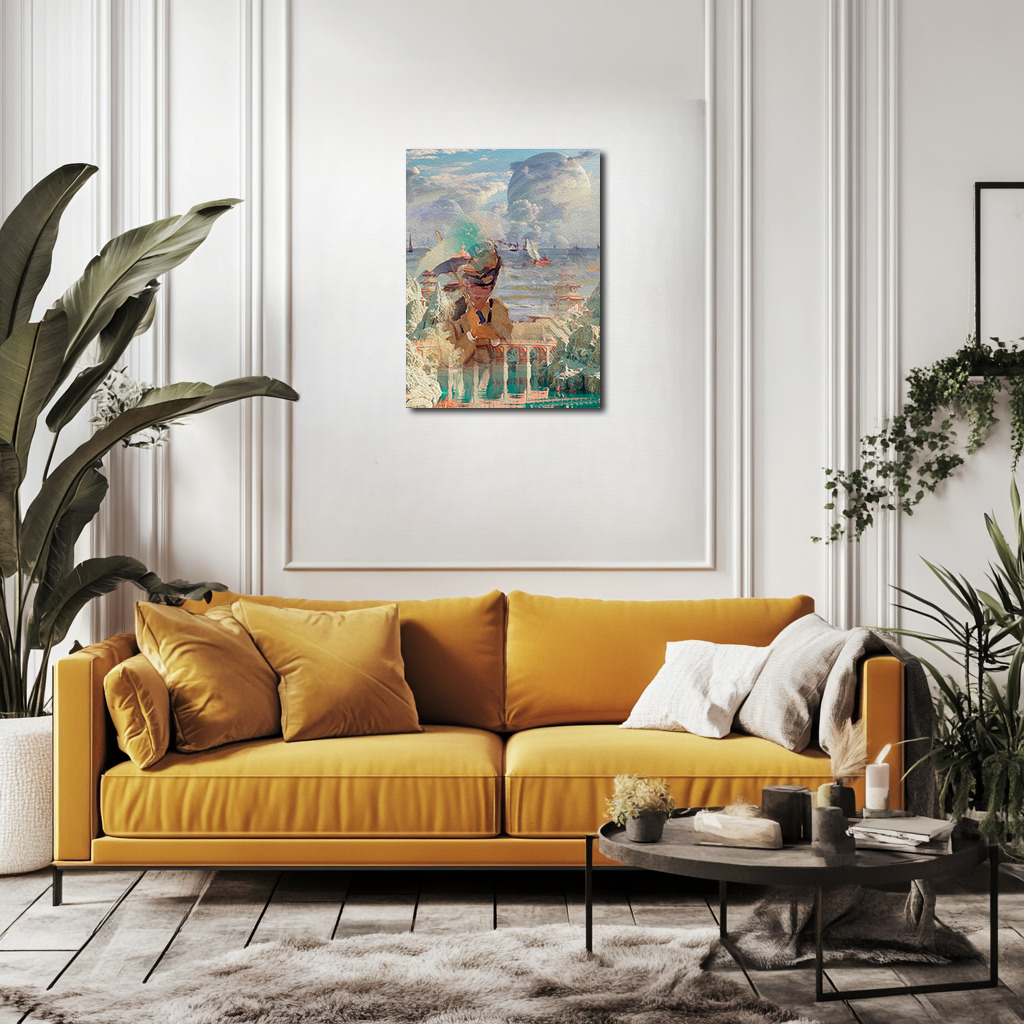Echoes of Trouville: Camille in a Dream of Worlds
"Echoes of Trouville: Camille in a Dream of Worlds" reinterprets Monet’s Camille Sitting on the Beach at Trouville through a surreal, collage-inspired lens. Camille’s figure dissolves into a dreamlike fusion of Impressionist beauty and celestial grandeur. Ancient Eastern-style structures rise from translucent waters, while distant planets hover in the sky, transforming the quiet seaside scene into a vast and timeless vision. This artwork explores how memory, history, and art intersect, blending Monet’s delicate brushwork with new layers of imagination. Camille no longer simply gazes at the sea—she becomes part of a cosmic reflection, existing in multiple realities at once.
Please see Below for Details…
Hotline Order:
Mon - Fri: 07AM - 06PM
404-872-4663
This surreal reimagining of Camille Sitting on the Beach at Trouville transforms Claude Monet’s quiet moment of leisure into a fragmented and layered dreamscape where time and place collapse into one. Originally painted in the summer of 1870, the original artwork captured Monet’s wife, Camille, elegantly dressed in a flowing white gown, seated by the sea as she watched the boats drift along the shore. In this conceptual collage, Camille’s figure dissolves into an otherworldly vision, suspended between reality and imagination, between past and future.
At the core of this piece, Camille’s portrait appears like a ghostly fragment, her form partially obscured by layers of shifting landscapes. She is no longer just a woman gazing at the horizon; she is a reflection of multiple realities, a presence that transcends time. Her face is partially abstracted, breaking into brushstrokes and melting into the scenery, suggesting a fading memory or an unfinished dream. The iconic parasol she once held now appears as an extension of the wind itself, blending into the clouds and sea, dissolving the boundary between subject and nature.
The surrounding environment, rather than depicting the gentle beaches of Trouville, now expands into a realm of fantasy. Ancient Eastern-inspired architecture emerges from crystalline waters, bathed in soft golden light, as if Camille has wandered into a utopian vision of a lost civilization. The traditional Impressionist sea and sky remain, but they are punctuated by celestial spheres, enormous planets looming in the background, evoking a sense of cosmic grandeur. Sailboats float on waters that reflect not just the sky, but a universe of unknown dimensions. The painting is no longer a simple moment by the beach; it is a window into a dreamlike world, where Camille exists as both an observer and a dreamer.
The color palette in this reinterpretation carries deep meaning. Soft pastel blues and gentle golds preserve Monet’s signature impressionist tones, evoking warmth and nostalgia. The deeper hues of celestial grays and ethereal whites suggest distance, time, and the erosion of memory. Camille’s fragmented appearance, painted with bold ochres and rich shadows, stands in contrast to the luminous surroundings, symbolizing the delicate balance between presence and disappearance, between what is remembered and what fades away.
As the artist, my intention in creating this piece was to explore the nature of perception and memory. Monet’s original artwork captured a fleeting, personal moment—a woman sitting by the shore, lost in thought. This reinterpretation expands that moment into a dream, a space where personal memories blend with collective imagination. By incorporating surreal elements like floating celestial bodies and ancient architecture, I wanted to suggest that our memories are not static; they evolve, shift, and merge with the images of our dreams and aspirations.
This piece also examines how we view art across time. Monet painted Camille Sitting on the Beach at Trouville during a time of personal and artistic transition, just before Impressionism would fully emerge. Today, we see his works through the lens of history, shaped by the many interpretations and movements that followed. This collage-style reimagining honors Monet’s vision while pushing it into new realms, showing how art never remains fixed—it expands, transforms, and breathes new meaning with each new observer.
Ultimately, Echoes of Trouville is a meditation on the impermanence of moments, the fluidity of identity, and the timeless quality of art. Camille, forever captured in Monet’s brushstrokes, now drifts through time and space, existing not just in 1870 but in every future that has imagined her since.
Add your review
Your email address will not be published. Required fields are marked *
Please login to write review!
Looks like there are no reviews yet.








